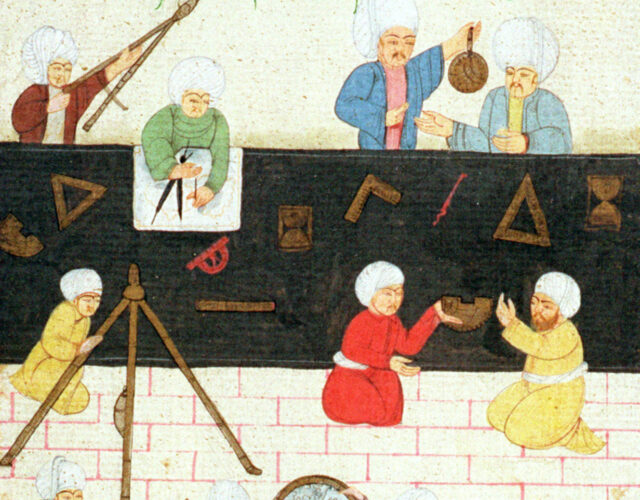Michael Hamilton Morgan. Lost History: The Enduring Legacy of Muslim Scientists, Thinkers, and Artists. Washington, D.C.: National Geographic Society, 2007. xviii + 301 pp. $26.00.
George Saliba. Islamic Science and the Making of the European Renaissance. Cambridge, MA: MIT Press, 2007. xi + 315 pp. $40.00.
The almost simultaneous appearance of two new books on Arabo-Islamic sciences draws renewed attention to the origins of the ideas that form the basis of today’s science and technology. Although it is widely recognized that the Arabo-Islamic world produced eminent scientific discoveries during the European Middle Ages, this has generally been a superficial assumption devoid of any more in-depth study. The two works discussed here will appeal to different audiences, yet they share two distinct and significant features: they trace the development of scientific thought in the Islamic world, focusing on science itself and not on religion; and they underline the continuous chain of transmission of theoretical and practical knowledge that unified the Mediterranean basin and the Middle East from classical Greece up to Renaissance Europe. The Greeks, Syriacs, Indians, Arabs, Persians, North Africans, Turks, and Mongols all form links in this chain.
Michael Hamilton Morgan’s Lost History is an entertaining popular work that traces a vivid picture of the history of Arabo-Islamic scientific thought. Each chapter opens with a brief narrative passage in which present-day fictional characters of Eastern descent realize that something in their knowledge of themselves and of their history is missing. These vignettes are the starting point for Morgan’s story of the Arabo-Islamic sciences and their legacy in modern Western societies. The author first provides a romanticized but reliable overview of the political and social history of Arabo-Islamic countries and then describes the historic achievements of scientists with short and vivid—if at times too imaginative—episodes of their lives in the context of the society in which they flourished. The central chapters of the book deal successively with the different areas in which Arabo-Islamic scientists excelled, while the last chapter offers a cursory description of some models of good government in the Islamic world in what seems to be a successful attempt to remind the reader of examples of tolerance and enlightened policy unmentioned in the pages of western historical textbooks.
Morgan acknowledges that his book is not scholarly, and he bases his research on secondary sources rather than original Arabic works. Still, he might have paid greater attention to the quoted passages, as when he identifies as a “forgotten Coptic chronicler” (p. 16) an author probably to be identified as John, Bishop of Nikiu, whose chronicle has been translated into French and English. There is also some inconsistency in the spellings of Arabic names. Attention to such details could have made this satisfying book good reading for a scholarly public as well.
In contrast, George Saliba’s Islamic Science and the Making of the European Renaissance is the fruit of more than 30 years of research on Arabo-Islamic sciences. Although the work is scholarly and historiographical, Saliba’s challenging arguments make for enjoyable and stimulating reading for a nonspecialized public as well. The first two chapters criticize traditional explanations for how Arabo-Islamic intellectuals became interested in Greek sciences during the Ummayad period (660–750) and translated an astonishing number of Greek scientific books during the ’Abbasid caliphate (750-1258). The beginnings of this translation movement were described by ’Al-Nadim in his 10th-century work, Fihrist, a primary source of information on early literary and scientific Arab-language texts. Saliba proposes a new reading of ’Al-Nadim’s narrative, arguing that traditional scholarship has failed to identify the importance of sociopolitical tensions between the Arabs and the other ethnic groups in the Islamic world after ’Abd al-Malik’s Arabization of the caliphal bureaucracy. After this reform, obtaining a position in the caliphal establishment required a sophisticated knowledge of astronomy and practical sciences. Such a requirement catalyzed a new and vivid interest in Greek scientific production, which was a relatively accessible source of information on these subjects.
The subsequent chapters analyze the critical approach of Arabo-Islamic astronomers who translated, used, and commented on Ptolemy’s Almagest, eventually leading to the invention of new devices that later made their way to the European Renaissance. Saliba devotes an intriguing chapter of the book to the missing links that must have made this new knowledge available to Copernicus, who seems to have consistently relied on Arabo-Islamic mathematical findings. Finally, Saliba criticizes traditional explanations for the decline of the sciences in the Islamic world, maintaining that they are based on preconceived ideas rather than on historical evidence. He shows, for example, that the astronomical theories that influenced European thought during the Renaissance were mainly produced during precisely the period when, according to traditional scholarship, Arabo-Islamic science declined.
The book’s rhetorical strength is weakened slightly in the central part of the work, where the subject is more technical. Moreover, while the title refers to Islamic science in general, Saliba’s book is mostly devoted to a detailed analysis of the birth, growth, and fortunes of Arabo-Islamic astronomy, which is taken—as the author points out in several passages—as a template for the development of Arabo-Islamic sciences in general. Whether Saliba’s theories prove valid outside of astronomy must be demonstrated by researchers in other fields of Arabo-Islamic studies.
The publication of these two books represents an important step for covering a much neglected aspect of Arabo-Islamic culture. In the present historical situation, in which studies of the Middle East tend to focus nearly exclusively on religion or politics, these two works offer the reader a different approach to Islam and the cultural heritage of Islamic lands. Together these two books continually stress the many historical interactions between the Arabo-Islamic world and the Latin West. This approach acts as a counterbalance for a prolific kind of literature that apparently aims at emphasizing differences and fomenting conflict.




